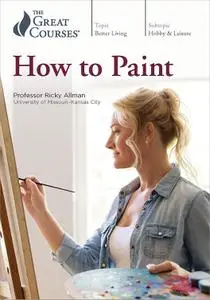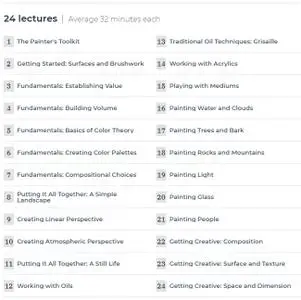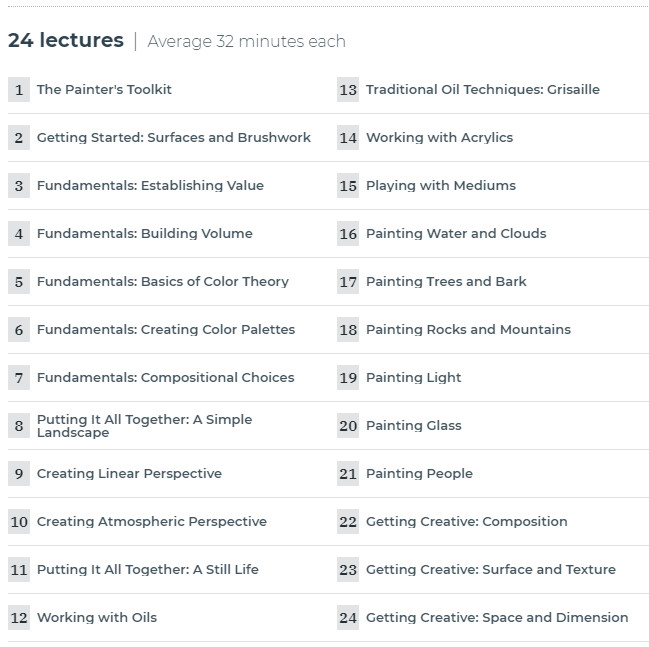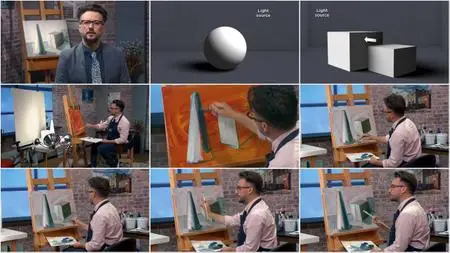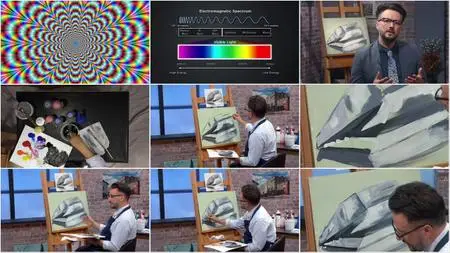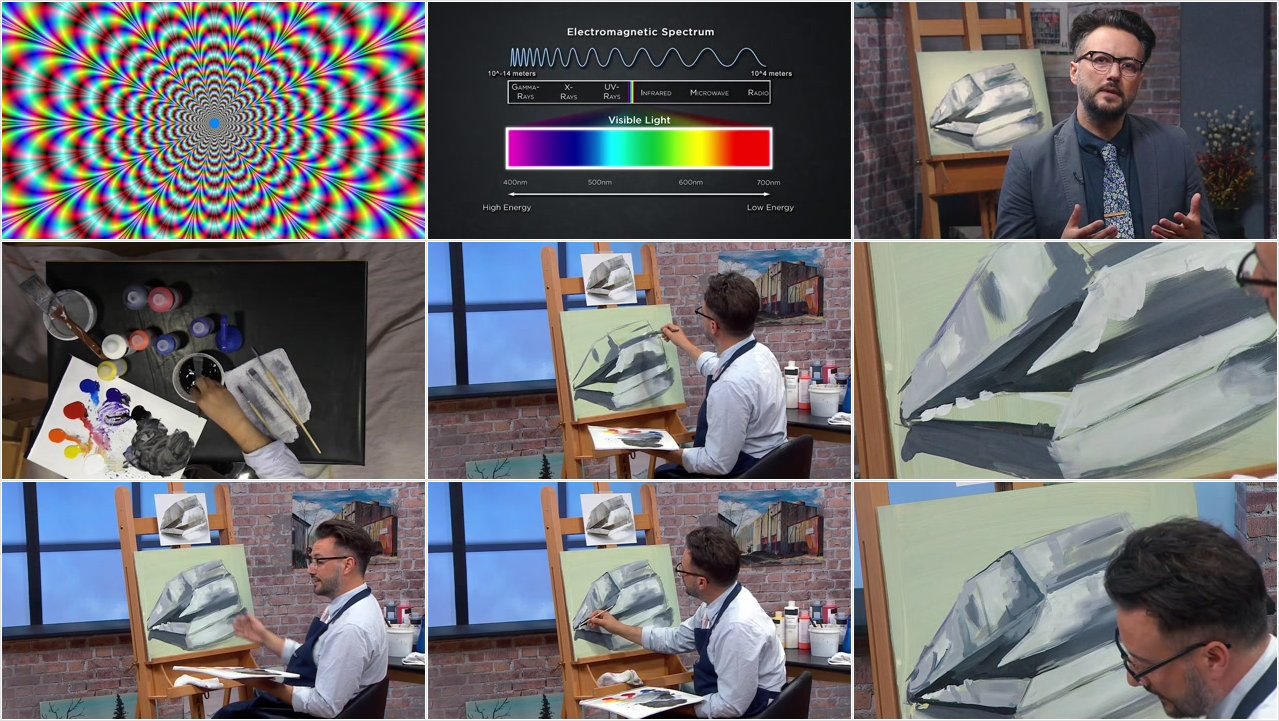TTC Video - How to Paint
Course No. 7827 | .MP4, AVC, 1370 kbps, 960x540 | English, AAC, 126 kbps, 2 Ch | 24x32 mins | + PDF Guidebook | 8.25 GB
Lecturer: Ricky Allman, MFA
Course No. 7827 | .MP4, AVC, 1370 kbps, 960x540 | English, AAC, 126 kbps, 2 Ch | 24x32 mins | + PDF Guidebook | 8.25 GB
Lecturer: Ricky Allman, MFA
Since the earliest days of human society, we have been painters. Lining ancient cave walls, the oldest known paintings in the world date back over 50,000 years. Despite the fact that painting is such an integral part of human civilization, many people feel intimidated by the medium. Perhaps the intimidation stems from the knowledge that some of the greatest works took years (or even a lifetime) to complete. Or maybe it’s the more technical aspects of painting that holds would-be artists back—the dozens of brush types, the unpronounceable pigments, the unfamiliar terms like chiaroscuro and grisaille. For these reasons and numerous others, painting can feel like an inaccessible art form. And yet, many people joyfully painted as children—who doesn’t smile when remembering the tactile thrill of fingerpainting or those little watercolor palettes of primary colors in elementary school?
Like drawing, creative writing, or musical performance, the ability to paint is a skill that can be learned and refined over time, by anyone. In the 24 lessons of How to Paint, taught by award-winning artist and professor Ricky Allman of the University of Missouri–Kansas City, you will get the art school experience from the very first demonstration. Not only will you learn how to select your tools and apply techniques, but you will also develop the visual skills and muscle memory that make painting an infinitely adaptable form of artistic expression. From understanding your painting surface and which brushes to use to utilizing reference images and learning the proper way to layer oil paint, you will join Professor Allman as he leads you step by step through hands-on demonstrations, with clear, illuminating explanations supported by numerous helpful graphics.
As you move through the lectures and follow Professor Allman’s tutorials, you will:
Become familiar with a variety of surfaces and discover how to choose what will work for you;
Learn how to use value, texture, color, perspective, and other tools to achieve amazing effects;
Compare and contrast working with oil paints and acrylic paints;
Explore both the technical and intuitive elements of painting;
Understand how to select subjects and compose elements; and
Look at different ways to approach painting still life, portraits, landscapes, and more.
Tools of the Trade
The sheer volume of implements and accessories available to a painter can be overwhelming. A variety of surfaces, easels, brushes, paints, pigments, thinners, mediums, and much more are widely available in a range of qualities and prices. So where do you start with so many choices? Professor Allman begins by helping you narrow your options from this plethora of materials so you can get started, beginning by looking at basic surfaces, the most essential brush types, and how to keep yourself from getting overwhelmed by limiting your color palette.
A crucial, often overlooked, aspect of painting is that painting is actually a very physical art form that requires the painter to learn new ways to move as well as new ways to see. To truly paint freely and with confidence, you must break certain habits and develop new ones. For example, since many of us are so used to writing, when you first pick up a brush to paint, you may be inclined to limit your motion to your hands. Painting, however, requires not just your fingers, but your wrist, elbow, and even shoulder to achieve the most expressive brushstrokes and to widen your visual field beyond the minute movements of your hands. Professor Allman shows you more than just how to approach the physical side of painting, including how to practice it regularly to build your skills, relax your approach, and enhance your repertoire of movements.
Other tools and techniques may be less tangible. Important to remember is that no painter works in a vacuum; thousands of painters have come before you. Their influence is not just inspiration, but also serves as a valuable tool for you to learn technique and to exercise your own skills. In the past, copying the work of masters was one of the primary ways apprentice artists learned their trade. While you will not copy other artists directly, these lectures feature a sampling of images from painters across the centuries. You will see items from nameless portraitists of the ancient world to the artists that have defined entire artistic movements, as well contemporary artists working today and pieces from Professor Allman’s own portfolio—all of which allow you to see technique in action and to enhance your appreciation of the painting tradition.
Master the Fundamentals
There are many techniques to master in painting that are specific to the medium, yet just as important are the visual tools that are intrinsic to visual art in general: value, composition, color theory, perspective, and more. Throughout the lessons, you will engage with—and continually refinehe foundational skills that will allow you to create dynamic images, from initial sketches all the way through to your finished piece.
You will begin your first forays into painting with acrylic paints and a few basic brushes, adding to your toolkit as you progress. After you have experimented with various techniques and have become comfortable with them, you will then move on to exploring the somewhat more challenging (though very rewarding) medium of oil paint, broadening both your range of tools and your repertoire of skills over the course of each lesson. Critcally important to the skill of painting is the ability to make artistic choices. Professor Allman walks you through the crucial decisions you will need to make that allow you to create the work that matches your vision.
Rules Are Meant to Be Broken
Before Picasso started rearranging his subjects into the experimental, two-dimensional abstractions of cubism he is best known for, he was a classically trained artist rooted in a realistic tradition. While it is true that you can start out painting in whatever manner or style you choose, it certainly helps to master the rules first—so you can break them with skill and confidence later.
As you follow along with his demonstrations, Professor Allman debunks some common misconceptions and reveals the immense range of possibilities you can discover through painting, exploring:
Why the Golden Ratio is not the only, and sometimes not the best, tool for composition;
When using a brush the “wrong” way—pushing paint rather than pulling it—can achieve unique (but hard to control) effects;
How a strong technical understanding of perspective can help create fantastical spaces in your work as well as realistic ones;
Why color itself is less important than other components, like value, contrast, and context; and
How surface texture can alter the visual experience of a painting, even though the viewer doesn’t actually “feel” the texture physically.
Join In an Illustrious Tradition
How to Paint immerses you in the painting process from start to finish, with step-by-step demonstrations in every lesson. Professor Allman’s years of experience as an artist and teacher enable him to provide the perfect introduction to an immense artistic tradition, infusing each session with passion and humor, so even the most technical and traditional methods become fun and approachable under his guidance. Though aimed primarily at beginners, this course offers an insider’s look at technique and offers methods and approaches that can help experienced painters elevate and expand existing skills as well.
By honing your observational skills and stretching your imaginative capacity, painting can quite literally help you see the world differently. Whether you work in oils or acrylics, favor realism or the abstract, or prefer landscape to still life, the tools and techniques you will learn can help you develop a wide range of skills that you can bring to any project or composition. Painters have been testing the boundaries and expanding the medium for thousands of years, creating an invaluable collection of resources that make it easier than ever for a new painter to pick up a brush and bring ideas to life. Now you can join that amazing tradition, too.
As you move through the lectures and follow Professor Allman’s tutorials, you will:
Become familiar with a variety of surfaces and discover how to choose what will work for you;
Learn how to use value, texture, color, perspective, and other tools to achieve amazing effects;
Compare and contrast working with oil paints and acrylic paints;
Explore both the technical and intuitive elements of painting;
Understand how to select subjects and compose elements; and
Look at different ways to approach painting still life, portraits, landscapes, and more.
Tools of the Trade
The sheer volume of implements and accessories available to a painter can be overwhelming. A variety of surfaces, easels, brushes, paints, pigments, thinners, mediums, and much more are widely available in a range of qualities and prices. So where do you start with so many choices? Professor Allman begins by helping you narrow your options from this plethora of materials so you can get started, beginning by looking at basic surfaces, the most essential brush types, and how to keep yourself from getting overwhelmed by limiting your color palette.
A crucial, often overlooked, aspect of painting is that painting is actually a very physical art form that requires the painter to learn new ways to move as well as new ways to see. To truly paint freely and with confidence, you must break certain habits and develop new ones. For example, since many of us are so used to writing, when you first pick up a brush to paint, you may be inclined to limit your motion to your hands. Painting, however, requires not just your fingers, but your wrist, elbow, and even shoulder to achieve the most expressive brushstrokes and to widen your visual field beyond the minute movements of your hands. Professor Allman shows you more than just how to approach the physical side of painting, including how to practice it regularly to build your skills, relax your approach, and enhance your repertoire of movements.
Other tools and techniques may be less tangible. Important to remember is that no painter works in a vacuum; thousands of painters have come before you. Their influence is not just inspiration, but also serves as a valuable tool for you to learn technique and to exercise your own skills. In the past, copying the work of masters was one of the primary ways apprentice artists learned their trade. While you will not copy other artists directly, these lectures feature a sampling of images from painters across the centuries. You will see items from nameless portraitists of the ancient world to the artists that have defined entire artistic movements, as well contemporary artists working today and pieces from Professor Allman’s own portfolio—all of which allow you to see technique in action and to enhance your appreciation of the painting tradition.
Master the Fundamentals
There are many techniques to master in painting that are specific to the medium, yet just as important are the visual tools that are intrinsic to visual art in general: value, composition, color theory, perspective, and more. Throughout the lessons, you will engage with—and continually refinehe foundational skills that will allow you to create dynamic images, from initial sketches all the way through to your finished piece.
You will begin your first forays into painting with acrylic paints and a few basic brushes, adding to your toolkit as you progress. After you have experimented with various techniques and have become comfortable with them, you will then move on to exploring the somewhat more challenging (though very rewarding) medium of oil paint, broadening both your range of tools and your repertoire of skills over the course of each lesson. Critcally important to the skill of painting is the ability to make artistic choices. Professor Allman walks you through the crucial decisions you will need to make that allow you to create the work that matches your vision.
Rules Are Meant to Be Broken
Before Picasso started rearranging his subjects into the experimental, two-dimensional abstractions of cubism he is best known for, he was a classically trained artist rooted in a realistic tradition. While it is true that you can start out painting in whatever manner or style you choose, it certainly helps to master the rules first—so you can break them with skill and confidence later.
As you follow along with his demonstrations, Professor Allman debunks some common misconceptions and reveals the immense range of possibilities you can discover through painting, exploring:
Why the Golden Ratio is not the only, and sometimes not the best, tool for composition;
When using a brush the “wrong” way—pushing paint rather than pulling it—can achieve unique (but hard to control) effects;
How a strong technical understanding of perspective can help create fantastical spaces in your work as well as realistic ones;
Why color itself is less important than other components, like value, contrast, and context; and
How surface texture can alter the visual experience of a painting, even though the viewer doesn’t actually “feel” the texture physically.
Join In an Illustrious Tradition
How to Paint immerses you in the painting process from start to finish, with step-by-step demonstrations in every lesson. Professor Allman’s years of experience as an artist and teacher enable him to provide the perfect introduction to an immense artistic tradition, infusing each session with passion and humor, so even the most technical and traditional methods become fun and approachable under his guidance. Though aimed primarily at beginners, this course offers an insider’s look at technique and offers methods and approaches that can help experienced painters elevate and expand existing skills as well.
By honing your observational skills and stretching your imaginative capacity, painting can quite literally help you see the world differently. Whether you work in oils or acrylics, favor realism or the abstract, or prefer landscape to still life, the tools and techniques you will learn can help you develop a wide range of skills that you can bring to any project or composition. Painters have been testing the boundaries and expanding the medium for thousands of years, creating an invaluable collection of resources that make it easier than ever for a new painter to pick up a brush and bring ideas to life. Now you can join that amazing tradition, too.


